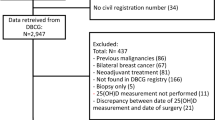Abstract
Low vitamin D levels have been associated with poor breast cancer outcomes in observational studies. We examined the association of vitamin D blood levels with relapse-free survival (RFS), breast cancer-specific survival (BCSS), and overall survival (OS) in the MA.21 randomized clinical trial. Fasting blood was collected pre-chemotherapy in 934/2104 (44.4 %) of subjects; 25 hydroxy vitamin D was measured (radioimmunoassay, Diasorin) in one batch. Vitamin D was assessed as a transformed continuous factor, and categorically (quartiles and clinical classifications). Univariate and multivariate prognostic analyses (adjusted for treatment, stratification factors, and baseline imbalances) were performed using Cox models. Most patients were young (median 47.8 years), white (91.6 %) and premenopausal (69.4 %) with grade III (52 %), HER2 negative or missing (89.5 %), ER positive (61.9 %), T1-2 (89.4 %), N + (72.7 %) breast cancer. Compared to the full population, those with vitamin D levels were more likely to be white, PS 1 or 2, to have undergone mastectomy, and to have an ER + tumor. Mean vitamin D was 69.7 nmol/L (27.9 ng/ml) and did not vary by tumor subtype. The majority (80.5 %) had levels >50 nmol/L (20 ng/ml), considered adequate by Institute of Medicine. Continuous vitamin D was not multivariately associated with RFS, BCSS, or OS (p = 0.36, 0.26, 0.33, respectively); categorical vitamin D was also not associated with outcome. Vitamin D associations with RFS did not differ within ER/HER2 subgroups. There was no evidence that vitamin D blood level was associated with RFS, BCSS, and OS in MA.21; the majority of subjects had adequate vitamin D levels at study entry.


Similar content being viewed by others
References
van der Rhee H, Coebergh JW, de Vries E (2009) Sunlight, vitamin D and the prevention of cancer: a systematic review of epidemiological studies. Eur J Cancer Prev 8(6):458–475
Bauer S, Hankinson S, Bertone-Johnson E (2013) Plasma vitamin D levels, menopause, and risk of breast cancer: dose-response meta-analysis of prospective studies. Medicine (Baltimore). 92(3):123
Amir E, Cecchini R, Ganz P (2012) 25-hydroxy vitamin-D, obesity, and associated variables as predictors of breast cancer risk and tamoxifen benefit in NSABP-P1. Breast Cancer Res Treat 133(3):1077–1088
Porojnicu A, Lagunova Z, Robsahm T, Berg J, Dahlback A, Moan J (2007) Changes in risk of death from breast cancer with season and latitude: sun exposure and breast cancer survival in norway. Breast Cancer Res Treat 102(3):323–328
Palmieri C, MacGregor T, Girgis S, Vigushin D (2006) Serum 25-hydroxyvitamin D levels in early and advanced breast cancer. J Clin Pathol 59(12):1334–1336. doi:10.1136/jcp.2006.042747
Goodwin PJ, Ennis M, Pritchard KI, Koo J, Hood N (2009) Prognostic effects of 25-hydroxyvitamin D levels in early breast cancer. J Clin Oncol 27(23):3757–3763. doi:10.1200/JCO.2008.20.0725
Rose A, Elser C, Ennis M, Goodwin PJ (2013) Blood levels of vitamin D and early stage breast cancer prognosis: a systematic review and meta-analysis. Breast Cancer Res Treat 141(3):331
Pritchard KI, LE Shepherd, Chapman JA, Norris BD, Cantin J, Goss PE, Dent SF, Walde D, Vandenberg TA, Findlay B, O’Reilly SE, Wilson CF, Han L, Piura E, Whelan TJ, Pollak MN (2011) Randomized trial of tamoxifen versus combined tamoxifen and octreotide LAR therapy in the adjuvant treatment of early-stage breast cancer in postmenopausal women: NCIC CTG MA.14. J Clin Oncol 10(29):3869–3876
Clark AS, Chen J, Kapoor S, Friedman C, Mies C, Esserman L, DeMichele A (2014) I-SPY1 investigators. Pretreatment vitamin D level and response to neoadjuvant chemotherapy in women with breast cancer on the I-SPY trial (CALGB 150007/150015/ACRIN6657). Cancer Med 3(3):693–701
Burnell M, Levine MN, Chapman JW (2010) Cyclophosphamide, epirubicin, and fluorouracil versus dose-dense = epirubicin and cyclophosphamide followed by paclitaxel versus = doxorubicin and cyclophosphamide followed by paclitaxel in node-positive = or high-risk node-negative breast cancer. Journal of Clinical Oncology 28(1):77–82
Holick MF (2007) Vitamin D deficiency. N Engl J Med 357:266–281
Ross AC (2011) The 2011 report on dietary reference intakes for calcium and vitamin D. Public Health Nutr 14(5):938–939
Chowdhury R, Kunutsor S, Vitezova A (2014) Vitamin D and risk of cause specific death: Systematic review and meta-analysis of observational cohort and randomised intervention studies. BMJ. doi:10.1136/bmj.g1903
Cescon D, Ganz P, Beddows S, Ennis M, Mills B, Goodwin P (2012) Feasibility of a randomized controlled trial of vitamin D vs. placebo in women with recently diagnosed breast cancer. Breast Cancer Res Treat 134(2):759–767
Acknowledgments
This work was supported by the Canadian Cancer Society Research Institute; Ontario Institute for Cancer Research; The Breast Cancer Research Foundation and Hold ‘EM For Life Translating Research Discoveries Into Breast Cancer Cures. The study sponsors have no role in the design of the study; the collection, analysis, and interpretation of the data; the writing of the manuscript; and the decision to submit the manuscript for publication.
Ethical Standards
Ethical standards conduct of the MA.21 study was performed in compliance with the research ethics board standards of the National Cancer Institute of Canada Clinical Trials Group and the participating centers. Ethical standards conduct of the vitamin D specific substudy was performed in compliance with the Mount Sinai Hospital Research Ethics Board in Toronto.
Author information
Authors and Affiliations
Corresponding author
Electronic supplementary material
Below is the link to the electronic supplementary material.
Rights and permissions
About this article
Cite this article
Lohmann, A.E., Chapman, JA.W., Burnell, M.J. et al. Prognostic associations of 25 hydroxy vitamin D in NCIC CTG MA.21, a phase III adjuvant randomized clinical trial of three chemotherapy regimens in high-risk breast cancer. Breast Cancer Res Treat 150, 605–611 (2015). https://doi.org/10.1007/s10549-015-3355-x
Received:
Accepted:
Published:
Issue Date:
DOI: https://doi.org/10.1007/s10549-015-3355-x




